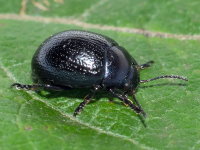Phylum Arthropoda (Arthropods) ➔ Subphylum Hexapoda (Hexapods) ➔ Class Insecta (Insects) ➔ Order Coleoptera (Beetles) ➔ Family Chrysomelidae (Leaf beetles)
Chrysolina (Colaphodes) haemoptera (Linnaeus, 1758)
Rotflügel-Wegerichblattkäfer Plantain Leaf Beetle
Synonyms and other combinations:
Chrysomela haemoptera Linnaeus, 1758 | Chrysomela acuticollis Fairmaire, 1877 | Chrysomela atra Goeze, 1777 | Chrysomela hottentota Fabricius, 1792 |
Classification:
Chrysolina haemoptera belongs to the subfamily Chrysomelinae, tribe Doryphorini.Distribution:
Europe, east to Caucasus; Turkey; Iran.Habitat:
Open, rather dry grassland (meadows, pastures, ruderal areas, nutrient-poor grassland, coastal dunes).Description:
Length 5 - 9 mm; body, legs and antennae blackish blue; antennal base reddish brown; pronotum finely dotted, straight from base to end, conically constricted and without lateral bulge; wing covers coarsely dotted and with deeply depressed seam strip at tip; dots on wing covers arranged in rows in places.Biology:
The Plantain Leaf Beetle Chrysolina haemoptera forms one generation per year. The beetles are mainly nocturnal and hide during the day. There are both long- and short-winged forms.The adults can be found from the beginning of June to July and after a summer diapause controlled by the length of the day from the end of August to October. Egg deposition begins in autumn and continues after wintering in the following spring to April. A female lays up to 200 eggs. These are laid at the base of the larvae' food plants. Host plants of the larvae are different plantain species (Plantago, Plantaginaceae). The larvae hatch 20 - 30 days after oviposition. The larvae hatched in autumn, overwinter with the adults of the previous generation and pupate in the soil in spring. The imagines of the new generation hatch from the end of May to the beginning of June.
When breeding under laboratory conditions, the pupation and hatching of the new generation took place already in October.
Natural Enemies:
The larvae of the tachinid fly Polycheta unicolor (Diptera: Tachinidae) are endoparasites of the imagines of Chrysolina haemoptera.The larvae of the fairy wasp (or fairyfly) Anaphes chrysomelae (Hymenoptera: Mymaridae) develop as endoparasitoids in the eggs of Chrysolina haemoptera.
References, further reading, links:
- Rheinheimer, Joachim, & Hassler, Michael: Die Blattkäfer Baden-Württembergs, 2018, 928 pages, Kleinsteuber Books (Karlsruhe), ISBN 978-3-9818110-2-5
- Arved Lompe: Die Käfer Europas - Ein Bestimmungswerk im Internet
- Agelastica alni
- Altica sp.
- Aphthona nonstriata
- Bromius obscurus
- Bruchus rufimanus
- Bruchus sp.
- Cassida nebulosa
- Cassida rubiginosa
- Cassida sp.
- Cassida stigmatica
- Cassida vibex
- Cassida vibex/bergeali
- Cassida viridis
- Chrysolina fastuosa
- Chrysolina haemoptera
- Chrysolina hyperici
- Chrysolina lucidicollis
- Chrysolina oricalcia
- Chrysolina sp.
- Chrysolina sturmi
- Chrysolina varians
- Chrysomela populi
- Chrysomela tremula
- Chrysomela vigintipunctata
- Clytra laeviuscula
- Clytra quadripunctata
- Coptocephala sp.
- Crepidodera aurata
- Crepidodera aurea
- Crepidodera fulvicornis
- Crioceris duodecimpunctata
- Cryptocephalinae sp.
- Cryptocephalus moraei
- Cryptocephalus nitidus
- Cryptocephalus pusillus
- Cryptocephalus sp.
- Donacia bicolora
- Donacia cinerea
- Donacia marginata
- Donacia versicolorea
- Galeruca tanaceti
- Galerucella s.l.
- Gastrophysa viridula
- Gonioctena decemnotata
- Gonioctena quinquepunctata
- Gonioctena quinquepunctata/intermedia
- Gonioctena sp.
- Gonioctena viminalis
- Lema cyanella
- Leptinotarsa decemlineata
- Lilioceris lilii
- Lochmaea caprea
- Neocrepidodera ferruginea
- Neocrepidodera sp.
- Oulema melanopus/duftschmidi
- Oulema obscura
- Pachybrachis sp.
- Phratora sp.
- Phratora vitellinae
- Phyllobrotica quadrimaculata
- Phyllotreta armoraciae
- Phyllotreta nemorum
- Phyllotreta vittula
- Plagiodera versicolora
- Plagiosterna aenea
- Plateumaris sp.
- Podagrica fuscicornis
- Psylliodes sp.
- Pyrrhalta viburni
- Sphaeroderma sp.
- Xanthogaleruca luteola



